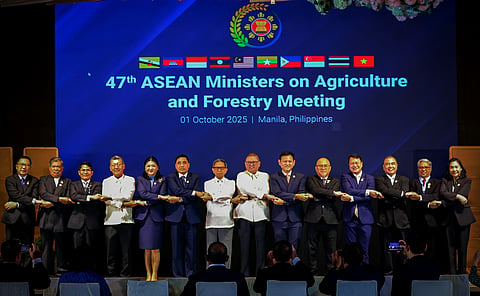
- NEWS
- the EDIT
- COMMENTARY
- BUSINESS
- LIFE
- SHOW
- ACTION
- GLOBAL GOALS
- SNAPS
- DYARYO TIRADA
- MORE

The ASEAN Ministers on Agriculture and Forestry (AMAF) outlined a regional plan to modernize and strengthen agricultural cooperation, with a focus on sustainable practices, resilient supply chains, and digital innovation — moves expected to drive new investment opportunities and enhance food trade integration across Southeast Asia.
Speaking at a press briefing during the 47th AMAF meeting on 2 October, Philippine Agriculture Secretary Francisco P. Tiu Laurel Jr. underscored the consensus among ASEAN member states to align agricultural growth with environmental sustainability.
He noted that the new initiatives will not only preserve ecosystems but also ensure long-term productivity, making the sector more attractive for investment and cross-border trade.
Strengthening ties
“This meeting strengthens ties among ASEAN countries. In times of market disruptions or emergencies, we can depend on one another to stabilize the prices of agricultural goods and ensure market balance,” Tiu Laurel said.
Two priority programs
As chair of this year’s AMAF, Tiu Laurel announced two priority programs that will guide ASEAN’s agricultural agenda through 2026 and beyond: the ASEAN Implementation Plan for Regenerative and Resilient Agriculture Systems, and the ASEAN One Billion Trees Growing Programme Initiative. Both are seen as key steps in advancing climate-smart agriculture while positioning the region to meet growing food demand.
The ministers also highlighted the importance of digital and smart agriculture solutions in improving efficiency and scaling food production, an area where private sector partnerships are expected to play a central role.
ASEAN + 3 reaffirms 9 strategic areas of collaboration
Meanwhile, ASEAN Plus Three (China, Japan, and South Korea) reaffirmed nine strategic areas of collaboration, including food security reserves, biomass energy development, sustainable forest management, biosecurity measures against animal and plant diseases, and R&D cooperation.
The framework also emphasizes enhancing product quality, marketability, and value chain development—all of which could open up new trade opportunities and boost competitiveness of agricultural exports.
